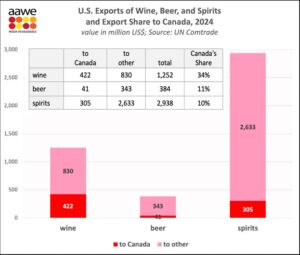 It’s been a busy week, hasn’t it. A freaky week. I think I’ll try to avoid much thought of the endtimes in this week’s update but, if you need more existential dread, I recommend what Jeff has shared. Good to be reminded by The Onion that mockery is a valid response. But I would say that in all the new battles of the tariffs, this fact was a bit surprising:
It’s been a busy week, hasn’t it. A freaky week. I think I’ll try to avoid much thought of the endtimes in this week’s update but, if you need more existential dread, I recommend what Jeff has shared. Good to be reminded by The Onion that mockery is a valid response. But I would say that in all the new battles of the tariffs, this fact was a bit surprising:
Canada’s retaliatory tariffs will hit the US wine industry harder than beer & spirits. Not only is the value of US wine exports to Canada higher than that of beer & spirits combined, wine industry exports are also more dependent on Canada: 34% of U.S wine exports go to Canada (beer 11%, spirits 10%)
Wow. Other than a few from Ridge stuck away for retirement and maybe a few Oregon Pinot, I never touch the stuff. And I won’t be touching any soon in my local LCBO:
March 4, 2025 – TORONTO – As part of Ontario’s response strategy to U.S. tariffs, the government of Ontario has directed LCBO to take operational steps to implement restrictions on all U.S. beverage alcohol sales and related imports into Ontario, effective immediately. LCBO has ceased the purchase of all U.S. products, retail customers are no longer able to purchase U.S. products on lcbo.com and the LCBO app, and wholesale customers, including grocery and convenience stores, bars, restaurants, and other retailers, are no longer able to place orders of U.S. products online. Furthermore, spirits, wine, cider, beer, ready-to-drink coolers/cocktails, and non-alcoholic products produced in the U.S. will no longer be available in our retail stores or LCBO Convenience Outlets.
Yup. Some places are clearing the shelves while others are selling off stock, like the funny folk at the Inuvik Liquor Store in the NWT.
 What else is going on? Well, I love this image shared on the FB page for the Brewery History Society submitted by one Paul Sutherland: highways, railways and seven breweries in:
What else is going on? Well, I love this image shared on the FB page for the Brewery History Society submitted by one Paul Sutherland: highways, railways and seven breweries in:
…aerial pictures of the Craigmillar area of Edinburgh taken I’m guessing in the 1930s. I got the originals when I worked at Tyne Brewery in the late 70s. In 2013 I submitted them to a website, now defunct owing to the death of its founder and administrator but still viewable, called Edinphoto. On September 21st of that year a member of the site called Andy Arthur, of Meadowbank, Edinburgh, annotated the pictures with the names of the breweries…
If you zoom in under this link, you will see how all that brewing and transportation infrastructure is pretty impressive… but is any of that still there almost a century later? Looks like it’s all part of the Innocent Railway Walking Path now. Speaking of all gone, here’s a life lesson: don’t leave two stories worth of heavy snow on the top level of the parkade. Bad move. No real beer connection other that I once parked in that very spot and went for a beer.
As we Canucks gird our loins and get all buy inter-provincial, Canada’s national broadcaster has revived the story of Gerald Comeau‘s beer run that ended up in the before the top appeal court panel in the land:
He certainly didn’t expect a police sting, a five-year legal battle and a Supreme Court of Canada decision saying he didn’t have the right to purchase that beer without impediment. “I can go buy any material anywhere in Canada. You can go buy 20 shirts in Quebec, no problem. Why wouldn’t you be able to buy beer,” said Comeau, over a decade after that fateful beer run. But Comeau’s quest to “free the beer” is once again in the spotlight as U.S. President Donald Trump threatens Canada with tariffs and interprovincial trade gets another look.
Yes, yes… I said I wouldn’t get into this but dropping inter-provincial trade barriers is one way we expect to be changing to fight the tariffs. Careful readers will recall our discussion (you and me, by the way, not the collective individual that marks some beer writing) of the Comeau case back in 2018 when the Supreme Court of Canada ruling came out defending a province’s autonomous right to stop you from buying beer in the next province. Will the Orange Blob’s tantrum change this?
Stan is fighting back, too. He is down by the Gulf of Mexico (Ed.: Mexico? Really?? Keep up with the lingo, Stan!) and he is actually saying so. Speaking of Stan, his latest edition of Hop Queries came out just after last week’s deadline and he shared the implications of the scything of the US federal government’s staff and their devestating effects on the US hops trade:
They include Francisco Gonzalez, a hop horticulturist who was 42 days from finishing his three-year probation period, and Brandon Sandoval, a biological science technician who worked for Gonzalez. Gonzalez had one measuring tape in any empty lab when he started, and now it is fully stocked. He spent two years building a six-acre experimental hop yard customized for irrigation studies, which was to operate at its full capabilities for the first time 2025. It appears both the lab and yard will be idle this year. Just as important going forward is the loss of support staff offering administrative, IT, and facility support services.
Yowza. Speaking of changes to the workplace, some spicy stuff in and about the normally mild mannered UK publication The Grocer on the appointment of a certain someone in what looks like a great leap sideways:
Steve Cox, the CEO behind failed beer business In Good Company (IGC), is to join Keystone Brewing Group a little over a month after its two major brands were swallowed up by the Breal-backed group. Cox moves to Keystone having failed to turn around the fortunes of Fourpure and Magic Rock Brewing, both of which were acquired by IGC from Australasian brewer Lion in 2022, but sold to Keystone in distressed circumstances at the end of January.
Staying over there, I like this story about a collective community hop garden developing in Thanet:
Hop Along Thanet, a non-profit making organisation which launched in 2020, encourages its members to grow the crop in their back gardens and allotment plots. The University of Kent at Canterbury has just joined the project and is set to grow 20 plants on its campus. Chris Morrissey, founding member, said: “Its more than a hobby, it’s an involvement with a historic Kent tradition”. Hop Along Thanet is one of a number of community hop growing groups across Kent. It has more than 50 members who have planted 150 hop bines in their gardens and allotments across Thanet.
Thanet was one of the great English brewing centers of the 1600s. Do they even know?
 What else? Well, probably best to not write and opinion column in you’re not interested in opinions. It can’t all be about hiding out, being the shadowy figure. Being negative can always be a positive. Like in this startling review of southwest Scotland as a travel destination:
What else? Well, probably best to not write and opinion column in you’re not interested in opinions. It can’t all be about hiding out, being the shadowy figure. Being negative can always be a positive. Like in this startling review of southwest Scotland as a travel destination:
You feel it’s hard to run a business here. It trickles through the scenery, undoing the beauty of the sky and the sea. The peeling paint and the rundown stores with their mossy window ledges add a tinge of gloom. On a mid-February weekend there weren’t many spots to spend money. You can’t get complacent about people coming for the beaches. You need to build around them to get cash flowing all year round. It isn’t enough to call southern Scotland “overlooked” or “forgotten” — two words beloved by travel writers and the tourist board. I am not certain it is our best kept secret.
Wow. And Wee Beefy is back with his first blog post of 2025 and it does somewhat countervale against the pub as convivial community centre line:
It was late on a midweek night in a popular Sheffield pub and probably about 30 minutes prior to closing. Two men I didn’t know came in and sat down and started chatting but quickly one expressed his extreme irritation at them playing rap music, a phrase he couldnt accurately pronounce. After a couple of minutes he shouted “why dont you play some proper music instead of this rap shit” His friend told him to stop shouting which riled him further so he decided to storm over to the counter and shout the same accusation directly at the barman – who said, politely and calmly, that what they were playing was all music, and may even have suggested that some people liked the music they had chosen. Cue embolism number 2.
Katie got the nod in Pellicle for her piece on something she has been writing about for years in social media and in her newsletter The Gulp – her obsession with wheeled sport! This time the focus is on “Beer and Cyclocross in Belgium and The Netherlands”:
Near the startline of Namur’s citadel cyclocross course in Wallonian Belgium, two women with dark-dyed 80s bouffant mullets wander towards me, a beer apiece. It’s 10.30am. I take this as confirmation I really should be moving on from coffee by now. At a cyclocross race it’s not just Belgian culture and a sense of civic duty that keeps the pints coming. Beer has been essential to the sport since its inception thanks to local brewery sponsorship deals. Even now, podium finishers often receive beer-related prizes, whether that’s an oversized glass of locally-brewed blond, or a keg to take home. As a spectator, beer serves another important purpose.
Speaking of purpose – or perhaps lack thereof – I find this program allegedly aimed at deterring wrongdoing in the pubs of Wales a bit confusing:
The group – supported by North Wales Police and local publicans – work together to help tackle issues like anti-social behaviour to help keep workers and other guests safe. This week saw two people put forward for banning orders. It saw them both given five year banning notices from the pubs in the group. There are no details on the individuals or what they are alleged to have done.
I mean I think it’s a good idea but if you don’t know what earned these guys a five year ban… how are you going to avoid doing it yourself? Speaking of the unexciting… yawn – but it’s still “craft”, right?
“We are entering 2025 as a stronger company focused on end-to-end execution which is showing progress in a dynamic operating environment…”
Perhaps conversely – and more realistically – Jessica Mason reported this week on a forecasted further downturn for the US beer market:
…the BPI is a net-rising index and a leading indicator of industry performance based on survey responses from participating beer purchasers.” Jones explained that “the index surveys beer distributors’ purchases across different segments and compares them to that of previous years’ purchases”. According to Jones: “A reading greater than 50 indicates the segment is expanding, while a reading below 50 indicates the segment is contracting.” Jones revealed that “overall BPI fell to 35 (a 14-point year-over-year shift) while the at-risk inventory measure rose to 53”… “The index for imports continues to point to expanding volumes with a February 2025 reading of 55; however, that is 13-points lower than the February 2024 reading of 68,” he warned.
Finally – and not buying into that trend at all – Boak and Bailey were out on another rip this past weekend and in the update at Patreon page identified another way of managing low alc beer:
We also took the opportunity to try Proper Job 0.5 for the first time. It’s clean and has an appealing hop profile, as you’d expect, but it’s not quite enough to conceal that it’s a low alcohol beer. For us, Clear Head from Bristol Beer Factory probably still has the edge as it manages somehow to have a fuller mouthfeel. However, as we suspected, interesting things start happening when you mix the 0.5 with, er, proper Proper Job. A 50/50 blend is pretty satisfying; lighter and more gulpable than the full-on PJ, but with enough Proper Job character to convince. Petit Proper Job, if you will.
Interesting – and it’s always good to give that “but… the brewer’s intentions?!?!” stuff a good kick down the stairs and try out your own ideas.
Fine. I did have plenty of stories about the crisis… but as promised I didn’t put much thought into it! Aaaannnnd… that is it for this week. Remember – however bad it was this week it will be worst next week. In the interim, please check out Boak and Bailey every Saturday and Stan going strong again each and every Monday. Then listen to Lew’s podcast and get your emailed issue of Episodes of my Pub Life by David Jesudason on the (sometimes even but never) odd Fridays. And maybe The British Food History Podcast. And Phil Mellows is at the BritishBeerBreaks. Once a month, Will Hawkes issues his London Beer City newsletter and do sign up for Katie’s wonderful newsletter, The Gulp, too. The Share looks to be back with a revival. Ben’s Beer and Badword is out there with the all the sweary Mary! And check out the Atlantic Canada Beer Blog‘s weekly roundup. There is new reading at The Glass which is going back to being a blog. Any more? Check out the Beer Ladies Podcast. That’s quite good and they are revving up for a new year. And the BOAS podcast for the bro-ly. And the long standing Beervana podcast …except they have now stood down. Plus We Are Beer People. The Boys Are From Märzen podcast appears suspended as does BeerEdge, too. VinePair packed in Taplines as well. All gone. But not Ontario’s own A Quick Beer featuring… Michigan! There is more from the DaftAboutCraft podcast, too. All About Beer has sponsored trade possy podcasts and there’s also The Perfect Pour. Plus follow the venerable Full Pint podcast. And the Craft Beer Channel on Youtube. The Moon Under Water is gone which is not surprising as the ask was $10 a month. Pete Brown’s one cost a fifth of that – but only had the one post. Such is life.






